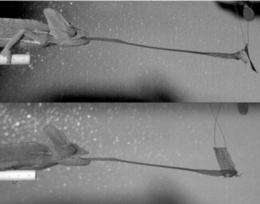March 10, 2010 report
Why chameleon tongues work in the cold (w/ Video)

(PhysOrg.com) -- In cold weather a chameleon’s metabolism slows down, but its tongue continues to work quickly to capture prey. A new study has found out why: the tongue does not rely on direct muscle contractions, and this mechanism is more resistant to cold than are muscles.
The veiled chameleon (Chamaeleo calyptratus) catches prey by shooting out its tongue, but since it is cold-blooded (ectothermic) it relies on the heat of its environment to keep warm. When temperatures drop, its muscles do not function as well as they do when it is warm. Now researchers at the University of South Florida, led by Christopher Anderson, have found the chameleon’s tongue accelerates at 41 Gs and reaches two body lengths, and that the mechanism for projecting it has additional benefits in cold weather. Scientists had previously assumed the chameleon’s special mechanism for shooting its tongue out was solely to produce the speed it needs to catch insects.
In ectotherms cold temperatures can considerably reduce their speed, and their ability to catch prey or escape from predators. In frogs, for example, the distance they can jump can be reduced by more than a third in cold weather. The special mechanism that operates the chameleon’s tongue, however, means they can feed at all temperatures in their habitats, from 3.5°C in mountainous areas up to 39°C in the desert.
The tongue mechanism is a stretch-and-release system, rather like a bow and arrow. Elastic tissue in the tongue is stretched by a contracting muscle. The energy is stored in the elastic tissue and when it is released the tongue shoots out to catch the prey, reaching full length in only 70 ms, which is about a fifth of the time it takes to blink an eye. In cold temperatures the contracting muscle works more slowly, but the same amount of energy is stored in the elastic tissue.
The researchers used a high-speed camera, the photron, to compare the performance of the muscles that retract the tongue back into the mouth (which are affected by the cold) and the tongue projection mechanism at 15, 25, and 35°C. They found that the tongue retraction speed dropped by over 42% for each 10°C in temperature drop, but there was only a 10 to 19% drop in projection speed over the same temperature drop.
Anderson said the research may help scientists understand how temperature changes can affect behaviors in other animals. It may also find application for humans, such as in the design of prosthetic limbs that need to function well in low temperatures.
The new research is published in this week’s Proceedings of the National Academy of Sciences (PNAS).
More information: Ballistic tongue projection in chameleons maintains high performance at low temperature , Christopher V. Anderson, Stephen M. Deban, Published online before print March 8, 2010, doi:10.1073/pnas.0910778107
© 2010 PhysOrg.com


















